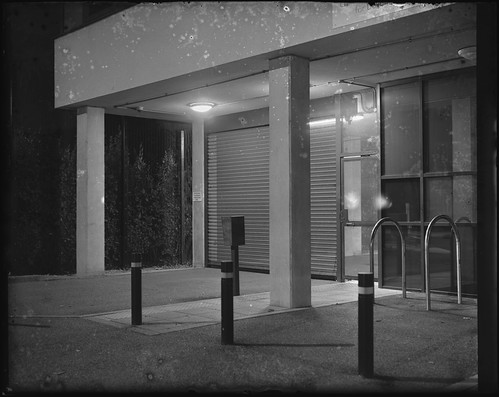 |
| Ilford Selochrome 4x5 inch glass plate |
In my posts about the ongoing glass plate night photography project, I've written about how some sizes are more common than others. Of all the relatively standard formats, 4x5 inches appear less frequently than quarterplate or the small metric and imperial sizes: in the past year I have only acquired two boxes in this size since using up the box of
Air Ministry plates.
 |
| Wratten & Wainwright Metallographic Dry Plates |
The first of these are
Wratten and Wainwright Metallographic Dry Plates. Wratten and Wainwright were a British company bought by Eastman Kodak in 1912 (a few years earlier, Eastman Kodak had made approaches to buy or merge with Ilford, presumably to gain larger market share in the UK). The Wratten name was used as a Kodak brand for many years afterwards, notably for filters and safelights, as demonstrated by the instructions at the top of the box. The Art Nouveau typeface used on the box label suggested that the plates were old, as did the explicit use of the phrase 'Dry Plates'; dry plates had been around since the last quarter of the 19th century and superseded the wet plate process, such that it quickly became reasonable to assume that photographic plates were
all of the dry variety, and none of the many other boxes of plates I've collected and used are described as 'dry plates'; indeed, even at the time one would never have found boxes of wet plates as a commodity, as the wet plate process required the photographer to coat a sheet of glass and then expose this in the camera before the emulsion had time to dry. The development of the dry photographic plate itself allowed the emergence of companies such as Eastman and Ilford to supply material to photographers, taking the step of preparing a light sensitive surface away from the photographer and into the business of mass production (however, as there are contemporary photographers who have revived the wet plate process prominently enough, when I mention shooting with glass plates, this becomes an occasional misunderstanding). The
reverse of the card inside the box has the numbers '5/35' at the bottom, which may be a date of printing. I have used a later version of
Metallographic plates before with some success.
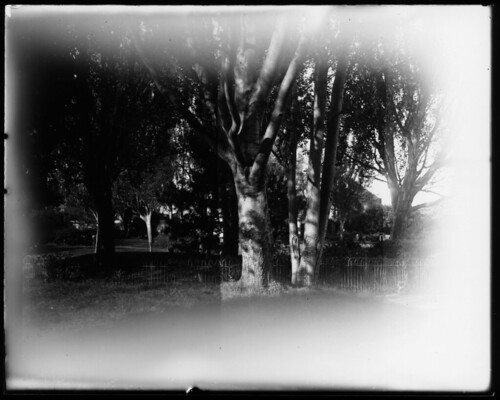 |
| Wratten & Wainwright Metallographic plate test |
The test shot shows the Wratten & Wainwright Metallographic plates to be heavily fogged at the edges, but clear in the central portion. I did shoot a couple of these plates at night, but I was disappointed with the impenetrable fog around the edges of the plates. I had previously achieved some good images from the box of Air Ministry plates which were of a similar age, but as I have found as a very general rule, Kodak plates on the whole have tended not to age as well as Ilford plates; most of the glass plates I've used over the last couple of years have been either Kodak or Ilford, and I tend not to buy Kodak plates now unless in a rare size such as 4x5 inches (I do not have any information as to which manufacturer supplied the Air Ministry plates).
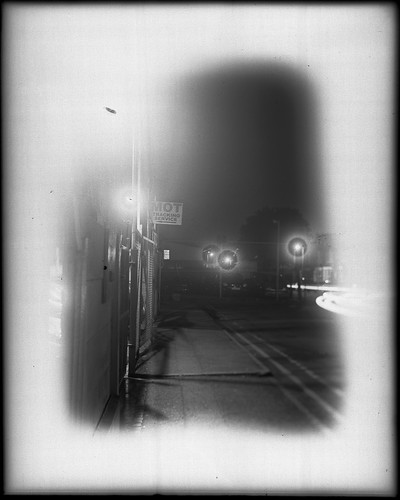 |
| Wratten & Wainwright Metallographic glass plate |
 |
| Ilford Selochrome 4x5 inch plates |
Around the same time I also bought an unopened box of
Ilford Selochrome 4x5 inch plates. These had a
leaflet inside which was dated to 1951. The wrapper around the box has two different styles of label:
on the side, the narrow label is a newer design, with Ilford written in a sans serif font. Like the Wratten and Wainwright plates, Selochrome is also orthochromatic (a panchromatic version of Selochrome was later made, at least as a roll film by Ilford, which I used on the last
127 Day). The
Ilford Manual of Photography describe Selochrome as "a fast plate for general purposes. Of average contrast. Fine grain and highly orthochromatic." I shot a test at the same time as the Metallographic plate. The result below looks relatively high in contrast, but this is in part due to the image being scanned from a contact print. The plates have aged quite well, with a few spotting marks, appearing on some plates more than others. The image at the top of this post is the best example of a photograph shot on these plates. I also shot the same scene on one of the
Wratten & Wainwright Metallographic plates for comparison.
 |
| Ilford Selochrome plate test |
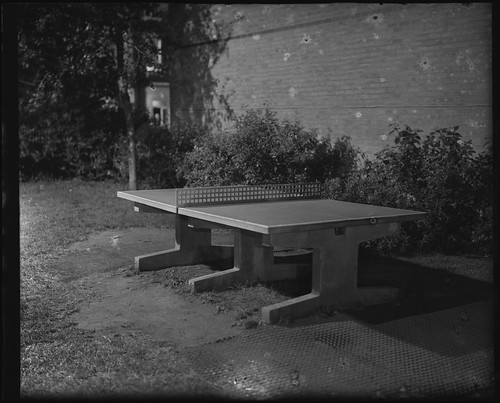 |
| Ilford Selochrome 4x5 inch plate |
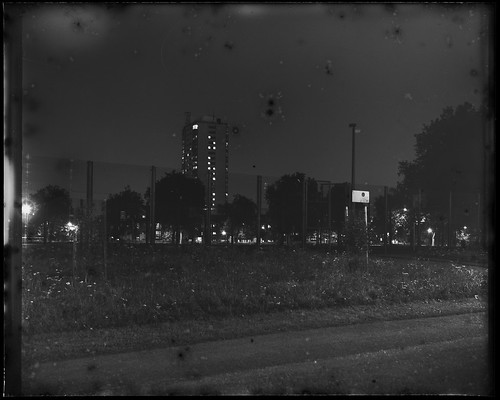 |
| Ilford Selochrome 4x5 inch plate |
As well as 4x5 inch plates, I am also including in this post
9x12cm plates. As mentioned in my post on the
Ica Trona 210, 9x12cm usually qualifies for large format. Last year, I wrote about finding
three previously opened boxes of 9x12cm plates, which I got a few good results from two of the boxes. Earlier this year, I bought a job lot of three boxes of
Ilford HP3, all previously unopened.
 |
| Ilford HP3 9x12cm glass plates |
I could see from the box style before bidding on the lot that these were possibly late 1960s or early 70s. When the boxes arrived, one was not sealed, but was full; I opened one of the other boxes to find the leaflet inside. This was dated to 1973, just two years from the end of plate manufacture at Ilford. What the
leaflet shows is just how many different types of plates (eight) were still being made at that late date. HP4 was introduced in 1966, but was made alongside HP3, and did not replace it for a number of years according to
Photomemorabilia's Ilford Chronology, possibly HP3 as a plate emulsion was continued until glass plate manufacture ceased, and HP4 is not listed on the leaflet from the box. At this late date the HP name is also given in full:
Hypersensitive Panchromatic. The boxes also contained 36 plates each - all previous boxes of photographic plates I've used contained, at least originally, one dozen (except for one half-dozen box). I suspect that at this stage it was uneconomical to sell plates in smaller amounts.
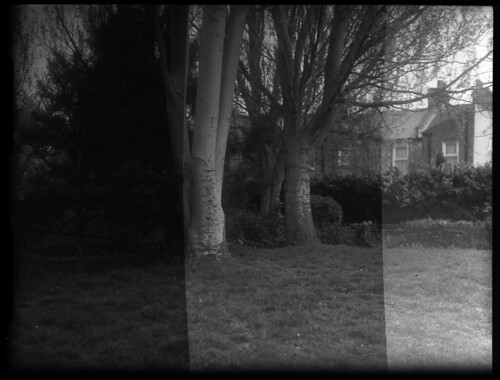 |
| Ilford HP3 plate test |
The test above shows that the plates are quite low in contrast, but there is little age deterioration beyond a loss in sensitivity. I rated the plate at 40 EI with three successive exposures, giving effective exposures of 40, 20 and 10. I shot some of the HP3 plates at night with my Voigtländer Avus where the low contrast was an advantage, but having three boxes of 36 plates, I was happy to divert some of the plates from my night photography project, and shot some with the Ica Trona handheld, rated 50, which I used to illustrated my post on the camera.
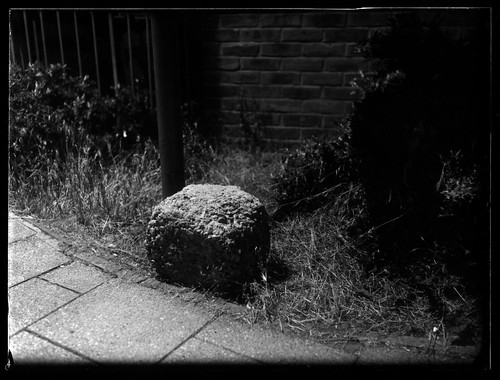 |
| Ilford HP3 9x12cm plate, shot with Voigtländer Avus |
 |
| Ilford HP3 9x12cm plate, shot with Voigtländer Avus |
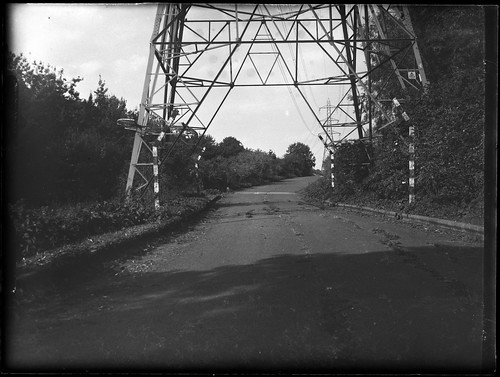 |
| Ilford HP3 9x12cm plate, shot handheld with Ica Trona 210 |
Sources/further reading
Company details from Early Photography
Ilford Chronology on Photomemorabilia













My Ilford N40 displayed the edge fading of your Wratten & Wainwright plates, but to a lesser degree. Had the box been opened? Is it simply age related? Air getting to the edges of plates quicker than the to the middle perhaps. Interesting halos around the streetlamps.
ReplyDeleteThe box was sealed. I wonder if it is humidity or temperature fluctuations, as the plates are all stacked together it would effect the central portions less. The Wratten & Wainwright plates are by far the most extreme version of this effect I've seen.
DeleteHi, are you still looking for glass plates? I have a few boxes of HP3 for sale. They are all unopened 12's
ReplyDeleteRaykayjay61@gmail.com if I teredted